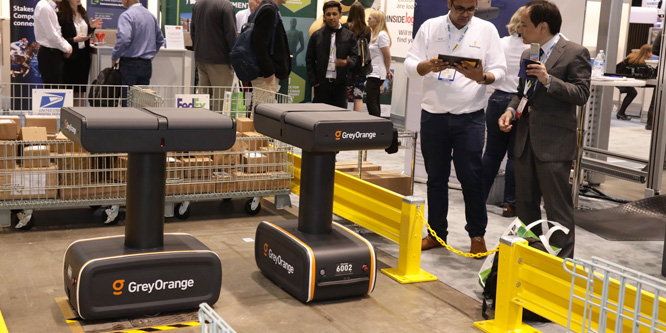
Photo: MHI/Modex 2020
Robots are everywhere!
Robots were certainly pervasive at ProMat last year, but Modex 2020, which alternates with ProMat as the major material handling trade shows of each year, featured even more. More kinds of robots performing more types of tasks from ever more companies. There were robot floor sweepers and shelf stockers, pickers and scanners, even truck unloaders. And there were some very sophisticated technologies to run the systems safely and efficiently.
MHI, which presents both Modex and ProMat, issues an annual survey of material handling companies and experts, and this year’s version, titled “Embracing the Digital Mindset,” found that the leading disruptive forces in technology are, first and foremost, robotics and automation. About two-thirds of respondents said this technology is having the biggest impact on their business, nearly 10 percent more than cited the next two disruptors — sensors and automatic identification and predictive analytics.
Two other very popular trends at trade shows over the past few years, artificial intelligence and the Internet of Things, followed in the survey. Inventory and network optimization, autonomous vehicle technology, wearable and mobile technology, cloud computing and blockchain were further back on the list. It should be noted that technologies like inventory optimization, mobile technology and cloud computing may no longer be considered disruptive by many experts and practitioners, who reported high adoption levels of these services.
At the session where the MHI study was released, Thomas Boykin, supply chain specialist leader at Deloitte Consulting, said that investments in digital technologies are increasing “fairly heavily” but that issues like the talent shortage and ever-increasing customer requirements are top hurdles that can hinder improved performance. “Expectations of faster, better, cheaper is also keeping these executives up at night,” he said.
A panel that discussed on the survey that included experts from Microsoft, The University of Tennessee and Locus Robotics was enthusiastic about the potential for technologies like predictive analytics, as well as robotics and automation, to advance supply chain efficiencies and free up scarce human talent to be redirected to higher-value processes. The panel also discussed how collaborative mobile robots can make human coworkers more efficient by drastically reducing the miles of empty walking involved in picking orders in warehouses and stores.
Discussion Questions
DISCUSSION QUESTIONS: What are the biggest product handling technology disruptors currently in use in the retail supply chain? Which ones do you expect to follow next?


History is showing that the most replicable human tasks are those first to be taken over by automation. As technology improves, more complex tasks will follow suit. The other factor is that as the move toward a substantial, mandatory minimum wage increases, this movement toward automation is accelerating. It’s simple economics.
Not that this is indicative of the future, but based on the current crisis, there are robots being used to spray disinfectants throughout retail stores, markets, streets and areas of public congregation. A great way to minimize risk and exposure to the virus. Almost as important, it demonstrates the versatility of robots to be adapted to current scenarios.
Robots are cool. We see them. We understand what they can do now and imagine what they can do in the future. But they are only one small piece of the supply chain. The future of the supply chain is the IoT. It will be point to point information, from where a product is sourced (including the raw materials) to where it is bought and when. The system will adjust and replenish. When there are hiccups in the supply chain, it will automatically make adjustments for from the farm or factory to the retailer.
We don’t get so excited about this because we can’t see it like we can see a robot, but that robot will take its orders through the IoT.
Retail inventory robots are a special instance of in-store sensing, which is undergoing an explosion currently. So far, they are pretty good for detecting out-of-stocks and deviations from the planogram (“find and fix”). They are not so good at detecting shelf quantity, which is essential for inventory order management that prevents OOS in the first place.
Put simply, the camera arrays are great at facings but still very bad at counting quantities on hand — especially when items are more than four-deep or “threaded” behind others on the shelves.
Advances in machine vision, AI, and communications bandwidth may eventually enable improvements on this limitation, but the challenge is harder than it looks (literally).
After more than 9 years of study, I am not a skeptic about any of this, however. IoT-based in-store sensing is the wave of the future. Robots (combined with other sensory systems) will “illuminate the invisible” in retail stores and provide stores with real-time operating data.
We already have proof that when store inventories are optimized, the benefits flow up the supply chain. Robots can’t gather the necessary data better than humans with hand-scanners — yet.